Overview
The article "9 Essential Tips for Small Winery Tasting Room Design" presents a commanding perspective on crafting an inviting and effective tasting room that not only enhances customer experience but also drives sales. It underscores the significance of key elements such as:
- Comfortable seating
- Effective storytelling
- Natural materials
- Accessibility
These components collectively contribute to an atmosphere that fosters guest engagement and loyalty, ultimately boosting direct-to-consumer revenue for small wineries.
Introduction
Designing a small winery tasting room transcends mere aesthetics; it involves crafting an experience that resonates deeply with visitors, transforming them into loyal customers. With the increasing focus on direct-to-consumer sales, winery owners are uniquely positioned to create engaging environments that reflect their brand narrative while enhancing guest comfort. But how can these spaces effectively balance style, functionality, and inclusivity to ensure that every visitor feels welcomed and connected? This article explores nine essential tips that not only elevate the design of small winery tasting rooms but also drive sales and foster enduring relationships with patrons.
Enocap: Transformative DTC Strategies for Small Wineries
Enocap empowers small vineyards to unlock direct-to-consumer revenue through innovative strategies that enhance profitability and customer engagement. With the average vineyard selling 70% of its production directly to consumers, developing robust DTC sales channels is crucial. Winery owners can implement a small winery tasting room design that not only attracts visitors but also turns them into devoted customers. Effective storytelling methods integrated into the small winery tasting room design create unforgettable experiences, ensuring that every element reflects the establishment's brand narrative. Enocap's comprehensive advisory services assist vineyards in crafting engaging stories that resonate with consumers, boosting sales and loyalty.
As Cathy Pedroncelli noted, 'Production and sales used to work in silos. Now, our winemakers are involved in sales planning. Real-time inventory brings everyone to the same table.' This holistic approach not only boosts sales but also nurtures enduring customer loyalty, positioning businesses for sustainable growth in a competitive market. Furthermore, addressing challenges such as cash flow issues and the need for meaningful connections with consumers is essential for maximizing the benefits of DTC sales. By embracing these strategies, vineyards can transform their operations and secure a prosperous future.
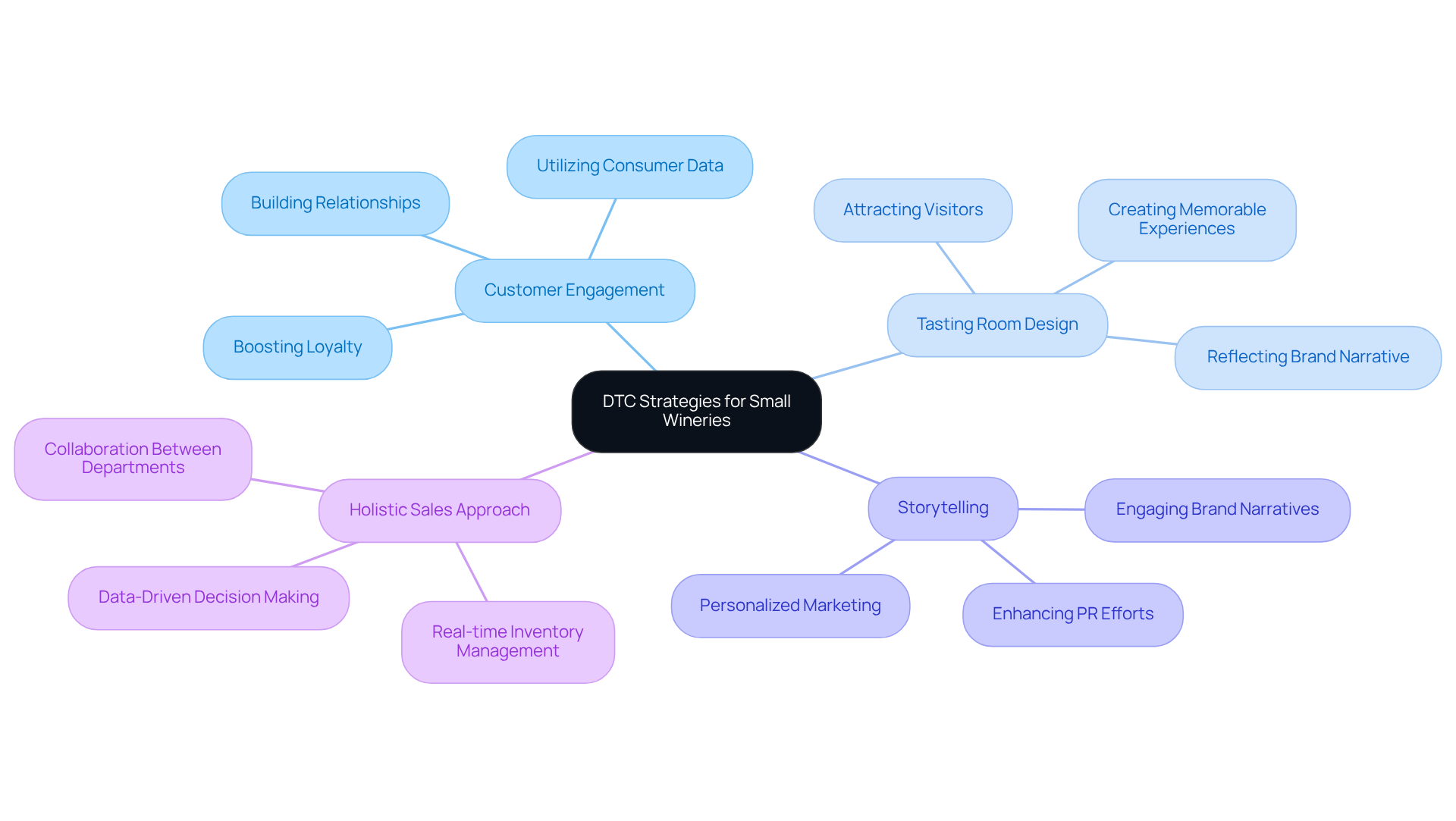
Create an Inviting Atmosphere: Key Elements for Comfort
Establishing a welcoming ambiance in the small winery tasting room design is paramount for enhancing guest experiences and driving sales, particularly through effective direct-to-consumer strategies. Comfortable furniture, warm color palettes, and engaging decor that reflect the establishment's unique brand story are essential elements. By integrating soft textiles and natural materials, establishments can elevate comfort and cultivate a welcoming atmosphere that resonates with visitors.
The small winery tasting room design must facilitate easy movement and interaction, allowing guests to explore wines and engage with staff seamlessly—this is vital for converting casual buyers into loyal club members. A thoughtfully designed space encourages visitors to linger, deepening their connection to the brand and increasing the likelihood of repeat visits.
Current trends in vineyard architecture emphasize multifunctional areas with small winery tasting room design that blend beauty with comfort, ensuring each visitor feels at home while enjoying their tasting experience. This approach not only enhances the guest experience but also promotes sustainable growth and loyalty, aligning with strategic capital planning for family-owned vineyards.
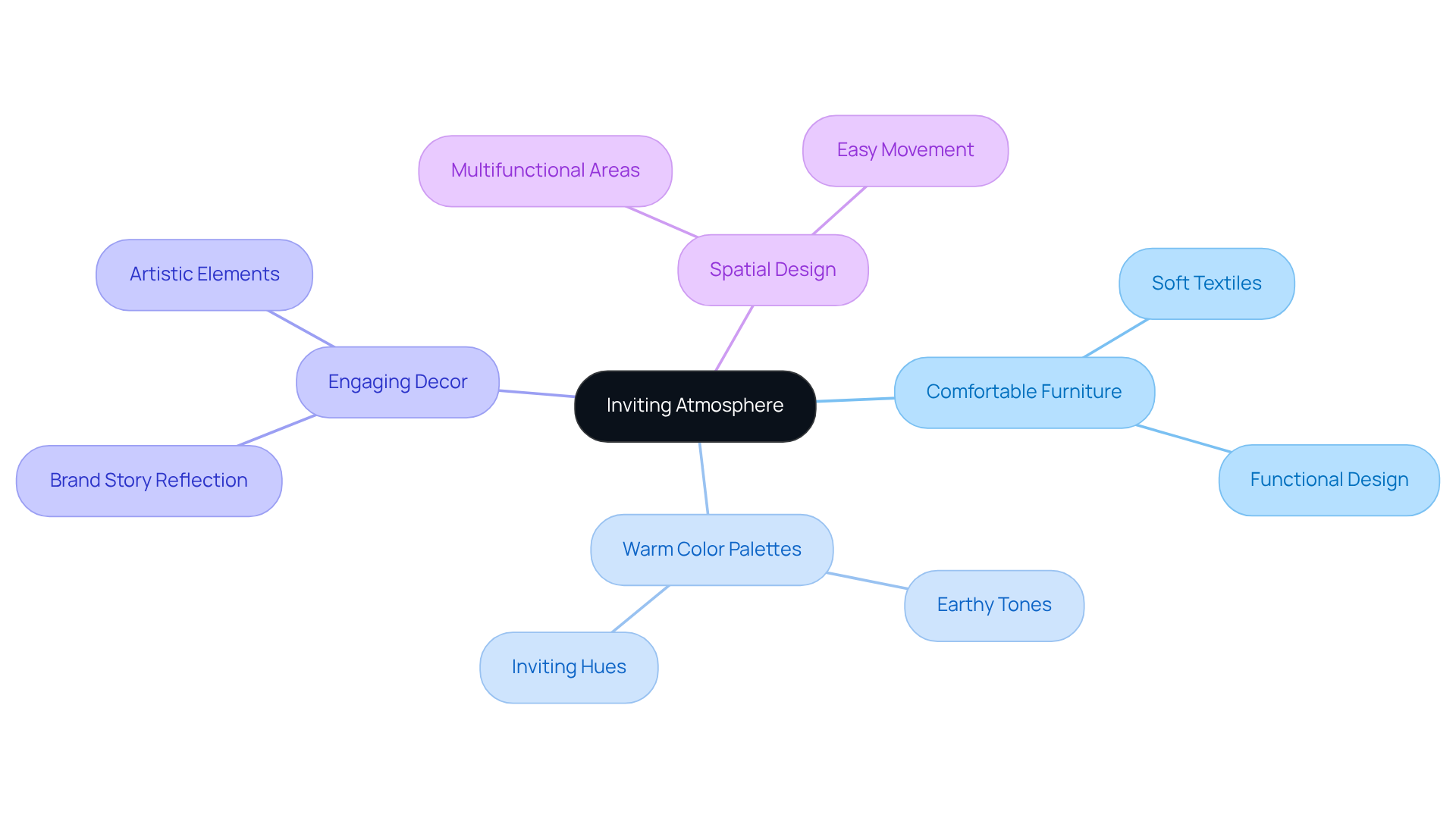
Reflect Your Wine: Design Elements that Showcase Identity
In your small winery tasting room design, incorporate creative components that embody the essence of your wines, such as color schemes inspired by the vineyard scenery or artwork that narrates the unique story of the estate. Effective signage in the small winery tasting room design must highlight the distinctive qualities of each wine, while the decor can reflect the winery's heritage and values. This thoughtful harmony between style and product in the small winery tasting room design not only enhances aesthetic appeal but also cultivates a deeper emotional connection with guests, significantly enriching their overall experience.
By crafting a compelling narrative through design, you can transform casual buyers into loyal club members, leveraging proven strategies that drive consistent growth. Furthermore, integrating strategic capital planning can bolster the winery's long-term success.
Research indicates that 82% of consumers primarily rely on labels to select their favorite wines, emphasizing the critical role of visual storytelling in creating memorable interactions.
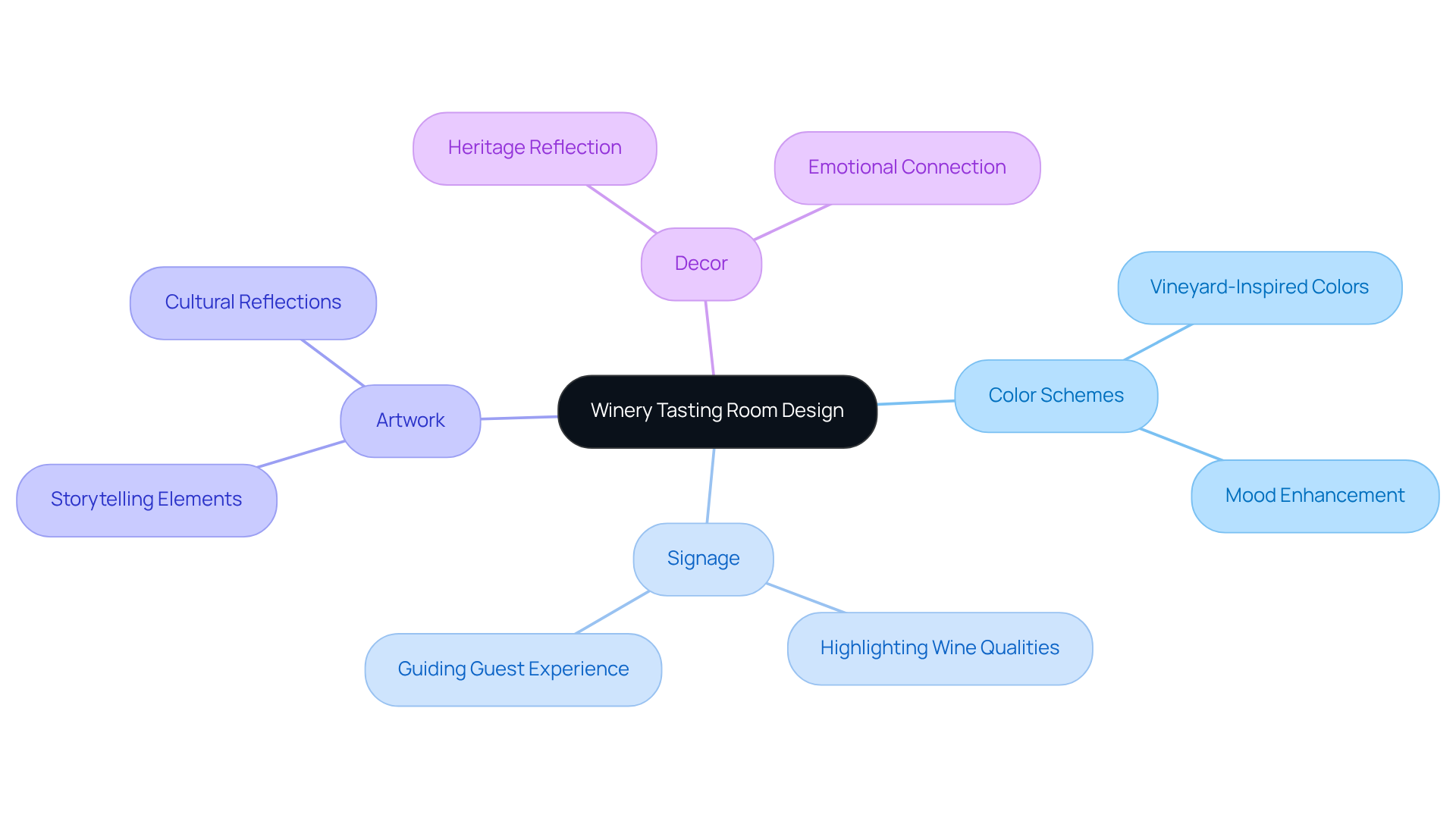
Work with the Environment: Integrate Natural Elements
To create a harmonious environment in the small winery tasting room design, utilizing natural materials such as wood, stone, and plants is essential. Large windows not only bring in natural light but also provide stunning views of the vineyard, effectively linking visitors to the very source of the wine.
Incorporating elements like living walls or indoor gardens into the small winery tasting room design can significantly enhance the ambiance, making it feel like an integral extension of the vineyard itself. This approach not only enriches the visitor experience but also reinforces the connection to the land, fostering a deeper appreciation for the wine produced.
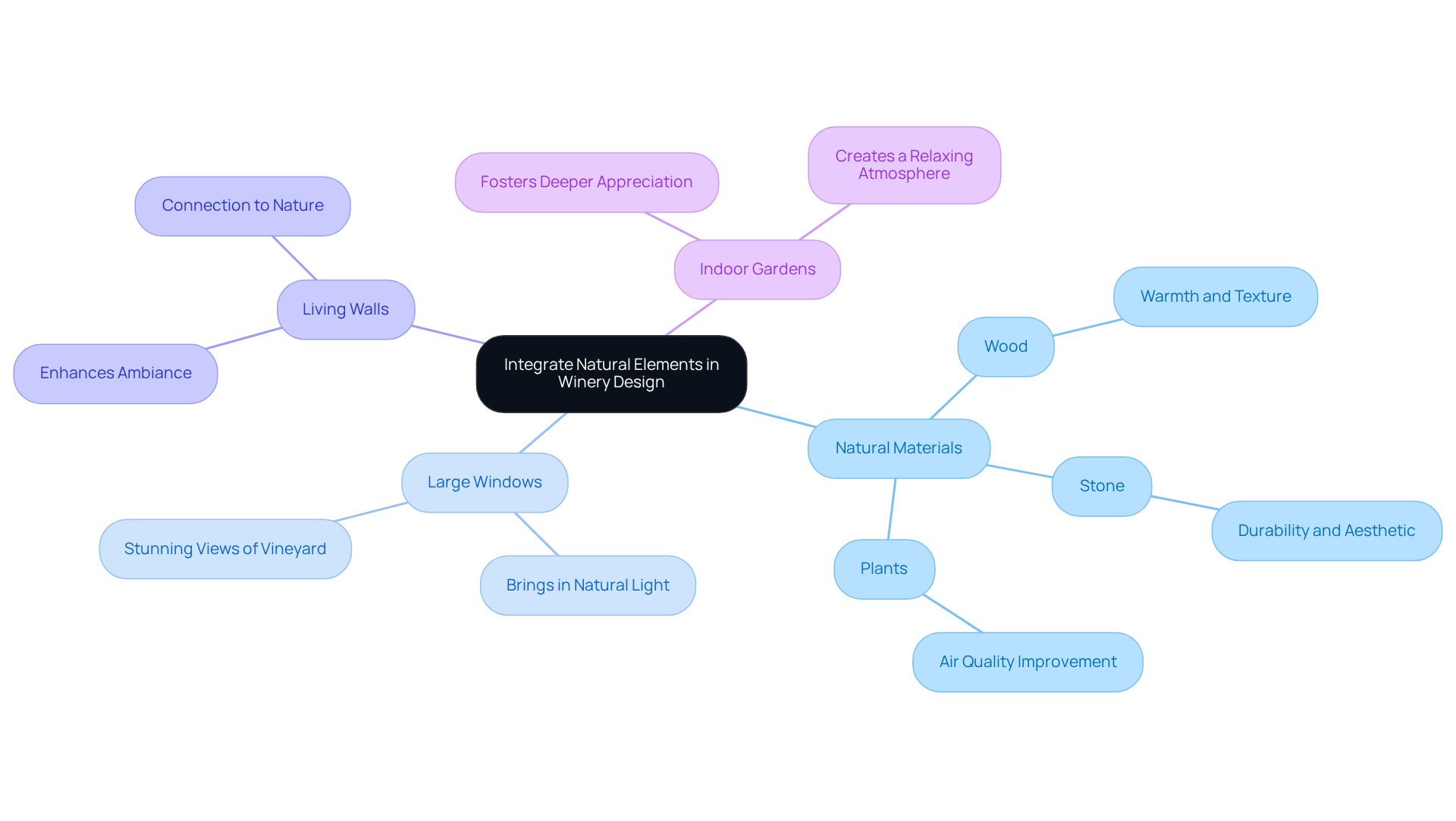
Provide Comfortable Seating: Enhance Guest Experience
To create an inviting atmosphere, offer a variety of seating options, including:
- Cozy nooks
- Communal tables
- Outdoor seating
This diversity not only caters to different preferences but also enhances the overall experience. Ensure that the seating is comfortable and conducive to conversation, allowing visitors to engage meaningfully with one another and the staff.
Consider the flow of the area carefully; avoiding overcrowding is essential. Guests should be able to navigate effortlessly between different sections of the room, promoting a seamless interaction that encourages longer visits and deeper connections.
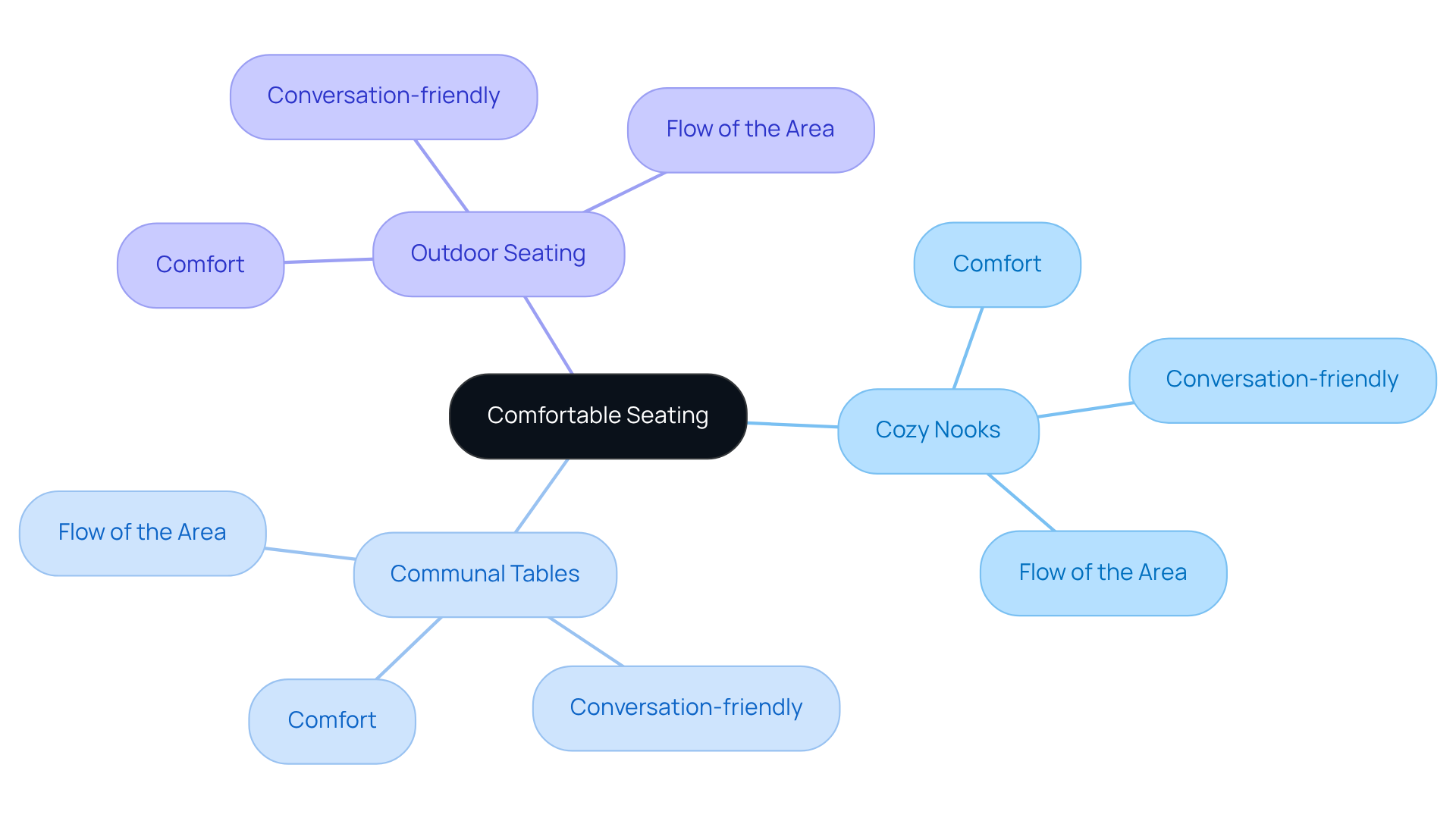
Utilize Mood Lighting: Create an Inviting Ambiance
Adjustable lighting is essential for creating distinct moods throughout the day in a winery setting.
- Employ soft, warm lights to cultivate a cozy ambiance during evening sampling sessions.
- Utilize brighter lights during daytime hours to effectively showcase the wines.
- Consider incorporating pendant lights or chandeliers that reflect the winery's unique style, adding an elegant touch to the space.
This strategic approach not only enhances the aesthetic appeal of the small winery tasting room design but also elevates the overall tasting experience for guests, making it memorable.
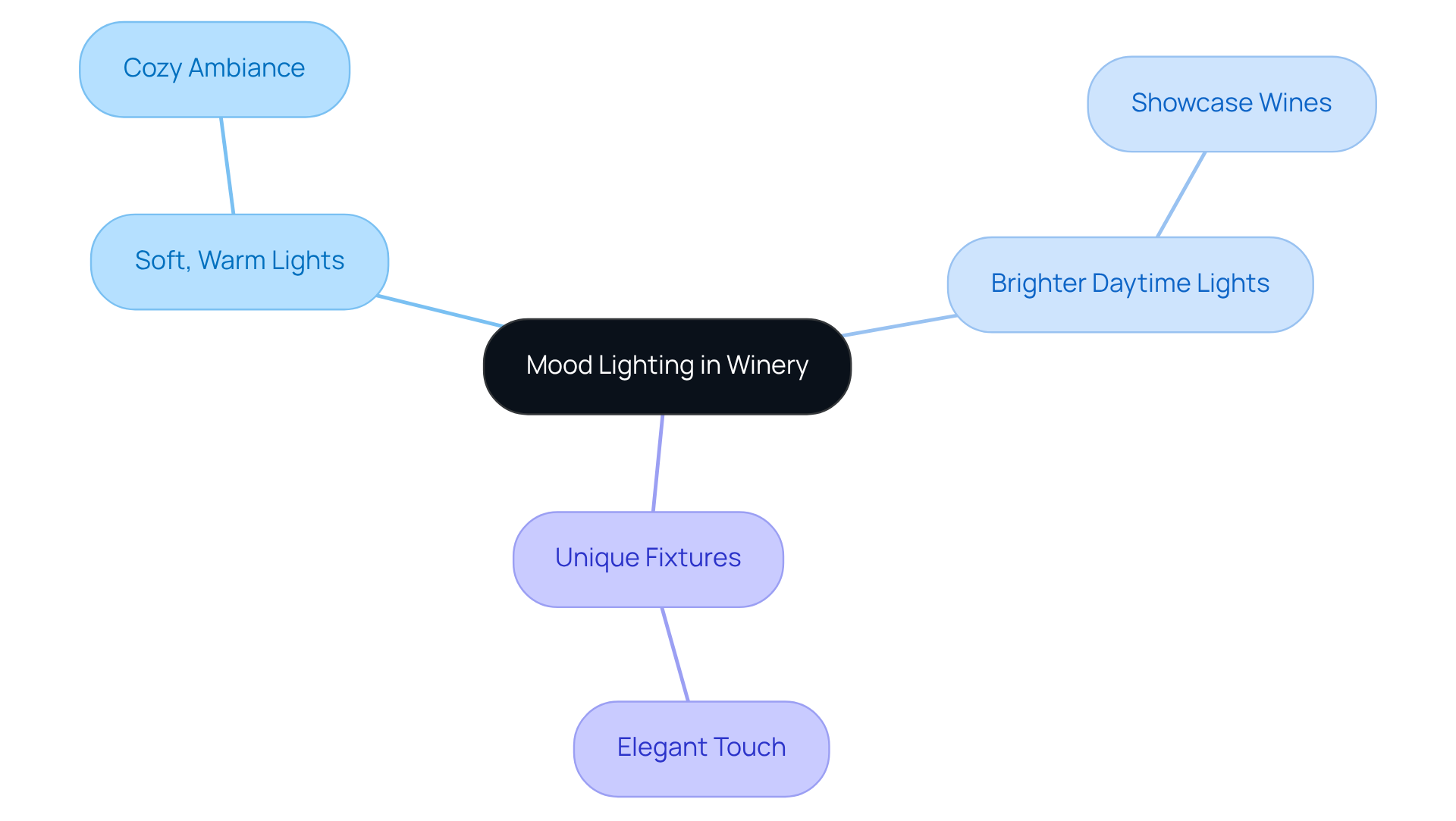
Incorporate Family-Size Tables: Foster Social Interaction
Incorporating large, family-style tables into your sampling area design is a strategic move that can significantly enhance social interaction among guests. These communal arrangements invite groups to come together, share their sampling experiences, and encourage them to try a broader selection of wines collectively, ultimately resulting in higher sales. Research indicates that communal seating arrangements can boost wine sales by fostering a sense of community and connection among visitors.
Strategically arranging these tables not only encourages conversation but also ensures a comfortable flow throughout the sampling area. This selection enhances the visitor experience and aligns with the growing trend of establishments aiming to create unforgettable, engaging atmospheres that resonate with consumers. By embracing this approach, you position your venue as a leader in creating memorable wine tasting experiences that drive both satisfaction and sales.
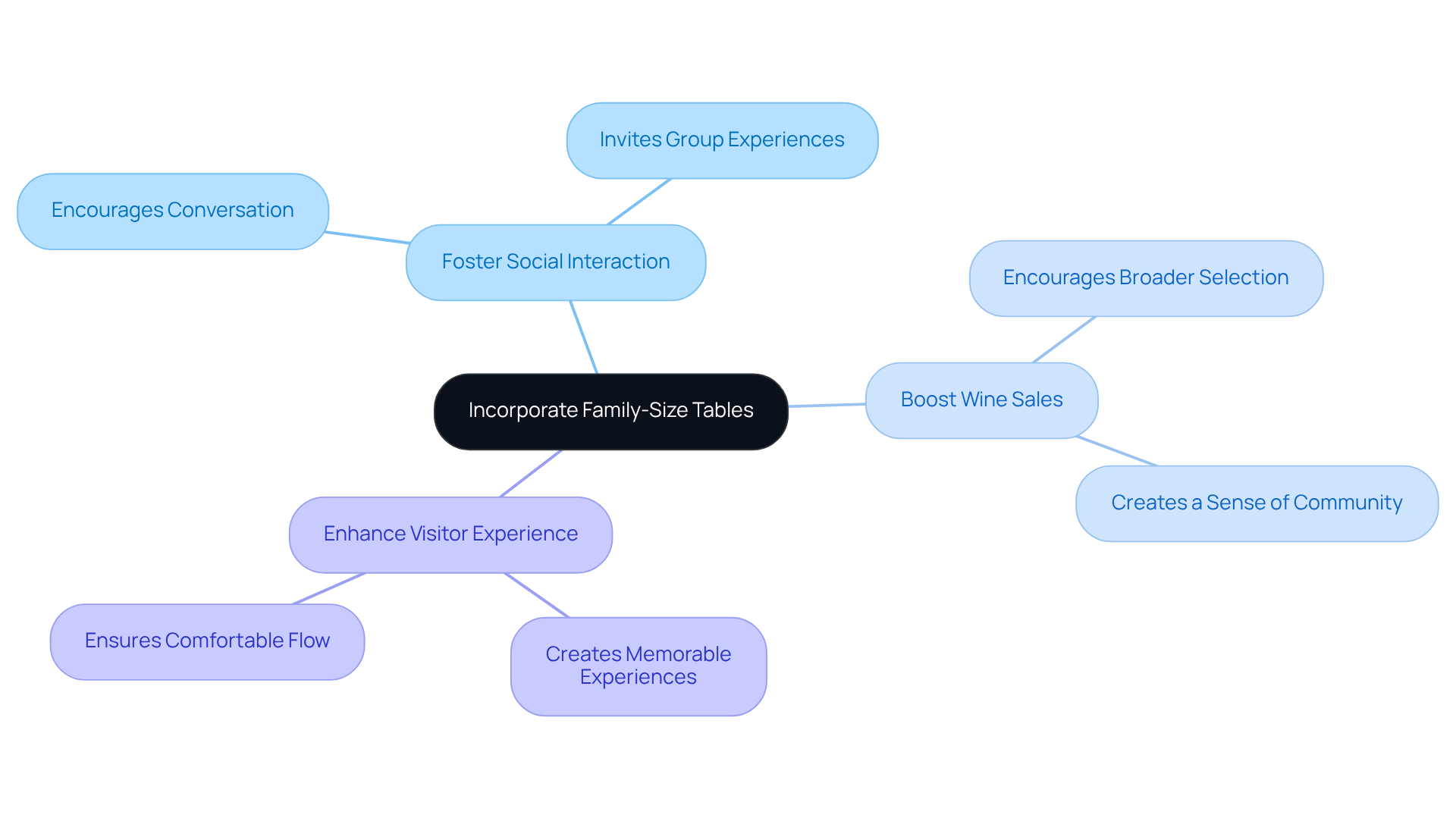
Combine Design Styles: Appeal to Diverse Tastes
By utilizing a small winery tasting room design that merges contemporary and traditional aesthetic components, a vineyard's tasting area can be transformed into an enchanting environment that captivates a diverse range of visitors. Merging modern furniture with vintage decor in the small winery tasting room design fosters an eclectic atmosphere, enhancing visual appeal and underscoring the establishment's innovative spirit. This approach not only attracts a varied clientele but aligns with research indicating that 94% of respondents believe aesthetics in small winery tasting room design significantly impact a hotel's success. Furthermore, 55% of hotel visitors prioritize style and aesthetics when selecting accommodations, a principle that is equally applicable to small winery tasting room design for vineyards looking to create unforgettable experiences.
As Yaiza, the creator of Tanic Design, asserts, 'Every small winery tasting room design should tell a story, making it memorable and welcoming for visitors.' By embracing diverse aesthetics in small winery tasting room design, vineyards can effectively cater to different preferences, ensuring a hospitable experience for all. For instance, establishments like [specific winery name] have successfully integrated contemporary and traditional features, creating inviting areas that resonate with their diverse patrons.
To implement these design concepts for your small winery tasting room design, consider incorporating distinctive decor items that reflect your establishment's narrative and values.
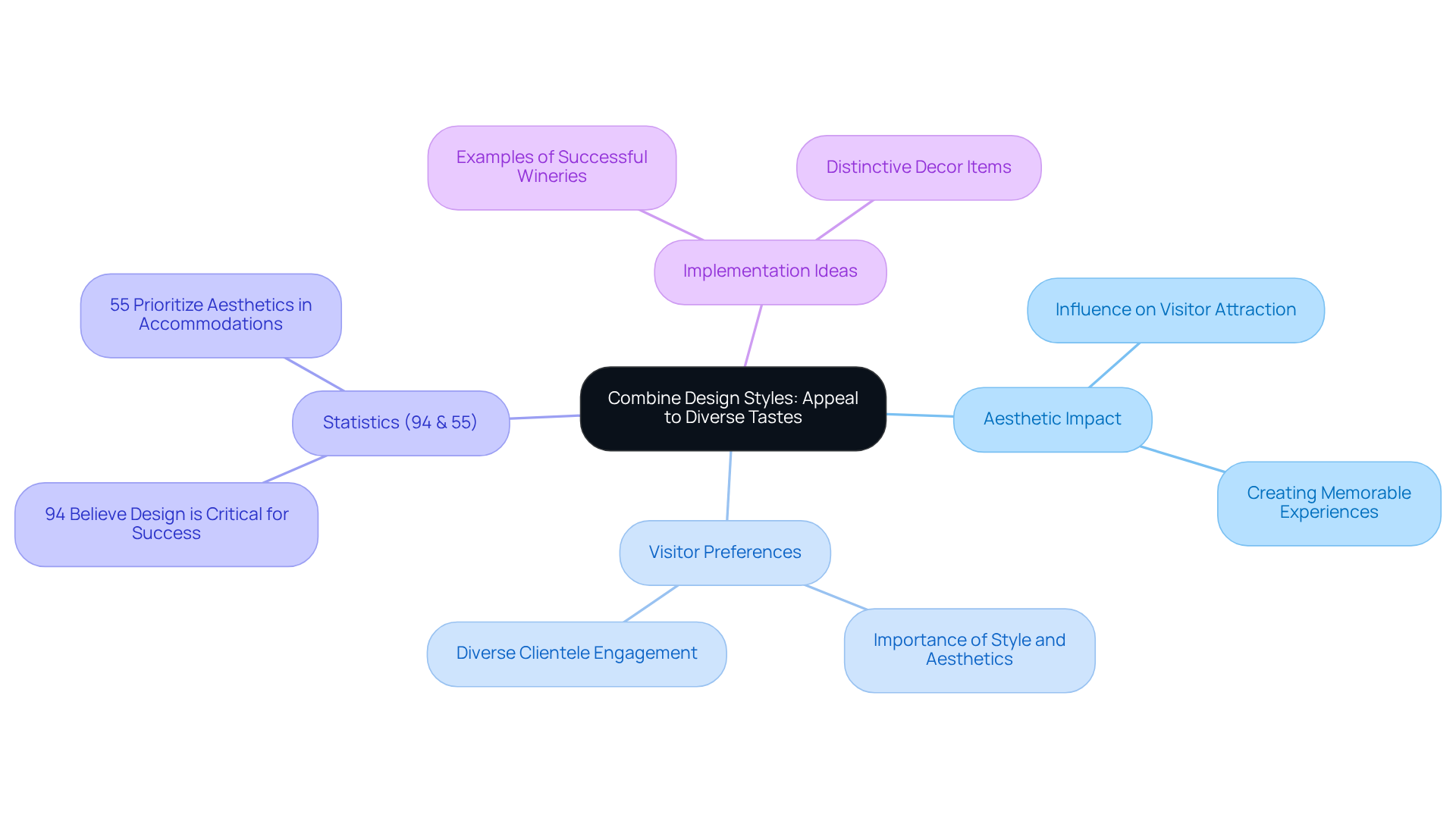
Utilize Outdoor Spaces: Expand Your Tasting Room
Establishing an outdoor sampling space is essential for enhancing the vineyard experience, allowing visitors to savor wines while immersing themselves in picturesque vineyard views. Thoughtfully crafted areas featuring comfortable seating, shade structures, and landscaping that aligns with the winery's aesthetic significantly elevate the experience and serve as a powerful direct-to-consumer strategy.
Outdoor environments not only present a refreshing alternative to indoor tastings but also cater to the increasing consumer preference for natural settings, which can effectively transform casual buyers into dedicated club members. Notably, wineries producing fewer than 1,000 cases annually reported an impressive 48% increase in visitors in 2024, underscoring the effectiveness of outdoor spaces in attracting patrons and driving consistent growth.
By prioritizing outdoor areas, these establishments can foster a relaxed atmosphere that encourages longer visits and deeper connections with their wines. Furthermore, the incorporation of outdoor spaces can be an integral part of a strategic capital planning approach, as these enhancements can lead to increased revenue and customer loyalty.
By implementing these strategies, wineries can amplify their appeal, unlock growth opportunities, and create unforgettable experiences for their visitors.
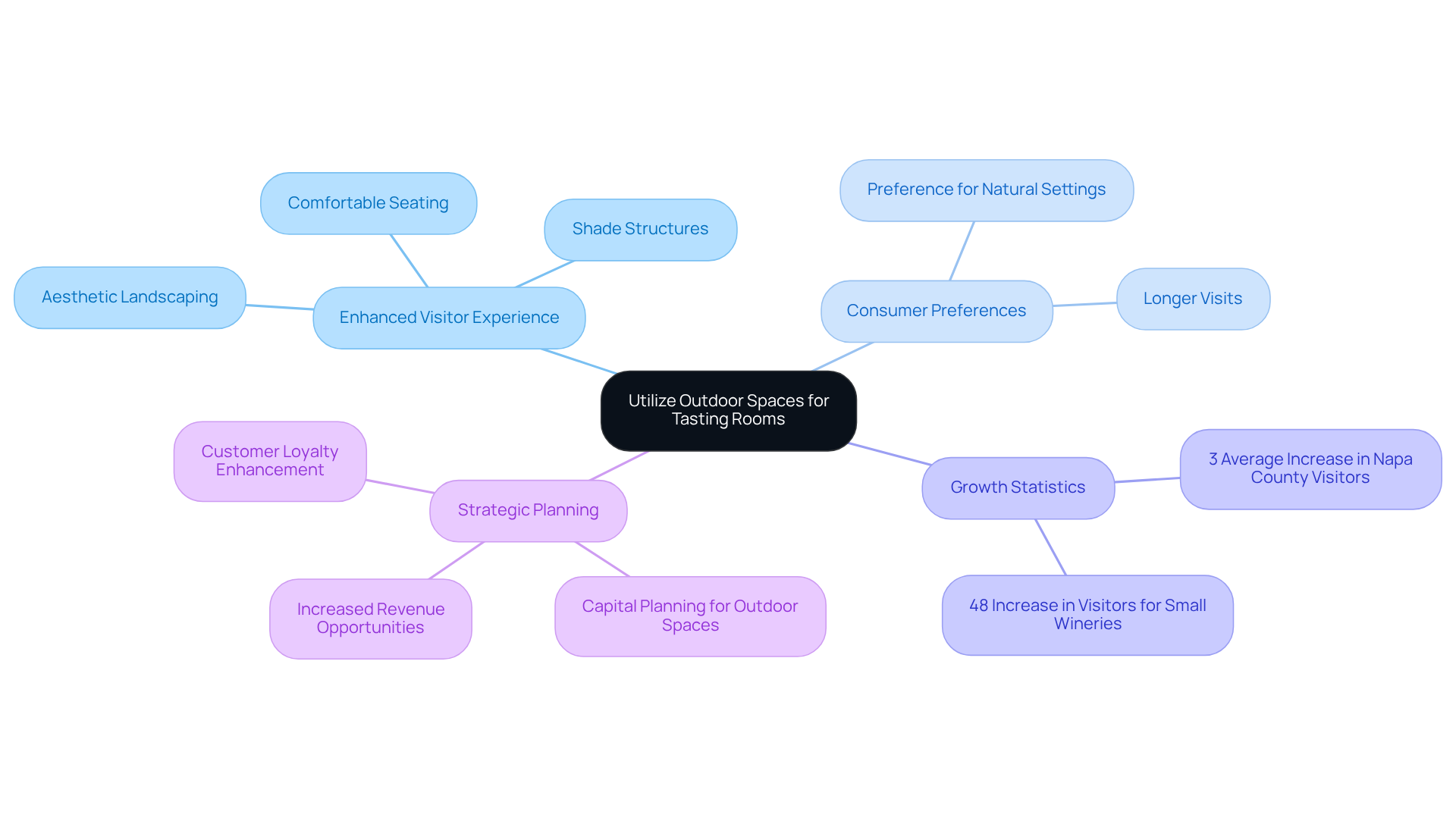
Ensure Accessibility: Create an Inclusive Environment
Establishing a small winery tasting room design with accessibility in mind is crucial for cultivating an inclusive environment that welcomes all individuals. Essential features such as clear pathways, ramps, and accessible restrooms guarantee that mobility-challenged visitors can navigate comfortably.
Thoughtful seating arrangements in the small winery tasting room design that accommodate wheelchairs not only enhance the experience for these guests but also foster a sense of belonging. Research demonstrates that vineyards prioritizing accessibility experience a notable increase in customer loyalty, as patrons value the commitment to creating an inviting atmosphere.
For instance, establishments like De Bortoli have successfully implemented inclusive design principles, setting a benchmark for others in the industry. By adopting these practices, small winery tasting room design can contribute to wineries building a loyal customer base and elevating their overall reputation in a competitive market.
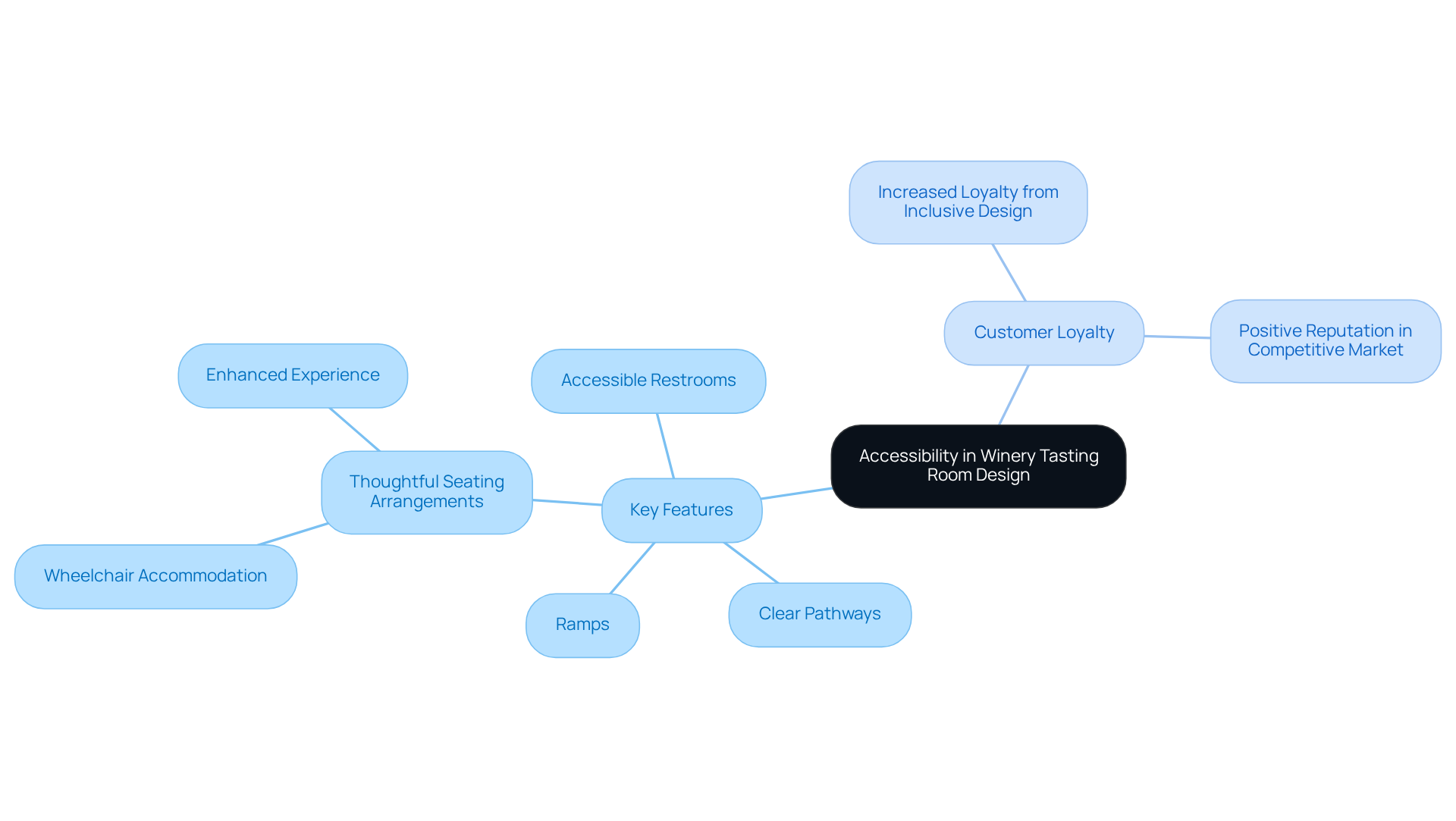
Conclusion
Designing a small winery tasting room is not merely an exercise in aesthetics; it is a strategic endeavor that balances comfort and functionality to elevate the visitor experience. By prioritizing direct-to-consumer strategies and fostering an inviting atmosphere, wineries can effectively convert casual visitors into loyal patrons. Each design element—ranging from seating arrangements to lighting and accessibility—plays a pivotal role in crafting an environment that resonates with guests and authentically reflects the unique identity of the wines offered.
This article underscores several critical aspects of effective tasting room design:
- A welcoming ambiance, achieved through comfortable seating and natural elements, cultivates deeper connections between guests and the winery's brand.
- Incorporating storytelling through visual elements and ensuring accessibility for all visitors enriches the overall experience.
- The strategic use of outdoor spaces can also significantly enhance guest enjoyment while simultaneously driving sales and fostering customer loyalty.
Ultimately, the success of a small winery tasting room is contingent upon its ability to create unforgettable experiences that encourage repeat visits. By implementing these essential design tips, wineries can enhance their immediate appeal and secure a prosperous future in an increasingly competitive market. Embracing these strategies will pave the way for enduring relationships with customers, transforming the tasting room into a vibrant hub of engagement and enjoyment.
Frequently Asked Questions
What is Enocap and how does it help small wineries?
Enocap empowers small vineyards to unlock direct-to-consumer (DTC) revenue through innovative strategies that enhance profitability and customer engagement, crucial for wineries that sell a significant portion of their production directly to consumers.
Why is a small winery tasting room design important?
A well-designed tasting room attracts visitors and helps convert them into loyal customers by creating unforgettable experiences that reflect the winery's brand narrative.
How can storytelling enhance the tasting room experience?
Effective storytelling integrated into the tasting room design creates memorable experiences, ensuring that every element of the space resonates with the winery's brand and engages consumers.
What holistic approach do wineries need to adopt for better sales?
Wineries should involve winemakers in sales planning and utilize real-time inventory management to foster collaboration between production and sales, boosting sales and nurturing customer loyalty.
What challenges do small wineries face in maximizing DTC sales?
Small wineries often encounter cash flow issues and the need for meaningful connections with consumers, which are essential for maximizing the benefits of DTC sales.
What key elements should be included in a welcoming tasting room atmosphere?
Comfortable furniture, warm color palettes, engaging decor that reflects the brand story, soft textiles, and natural materials are essential for creating a welcoming ambiance.
How does the design of the tasting room affect guest interactions?
A thoughtfully designed tasting room facilitates easy movement and interaction, encouraging guests to explore wines and engage with staff, which is vital for converting casual buyers into loyal club members.
What current trends are influencing small winery tasting room designs?
Current trends emphasize multifunctional areas that blend beauty with comfort, ensuring visitors feel at home while enjoying their tasting experience, which promotes sustainable growth and loyalty.
How can design elements reflect the identity of the winery?
Incorporating creative components like color schemes inspired by vineyard scenery, artwork that tells the estate's story, and effective signage showcasing wine qualities can embody the essence of the wines and enhance guest experiences.
What role does visual storytelling play in wine selection?
Research shows that 82% of consumers rely on labels to choose their favorite wines, highlighting the importance of visual storytelling in creating memorable interactions and enhancing the overall experience.




